Holy Roman Emperor
| Emperor of the Holy Roman Empire | |
|---|---|
|
Imperial | |
|
Quaternion Eagle | |
|
Francis II | |
| Details | |
| First monarch |
Charlemagne (as Emperor of the Romans) |
| Last monarch |
Francis II (as elected Roman Emperor) |
| Formation | 25 December 800 |
| Abolition | 6 August 1806 |
| Appointer | see Coronation of the Holy Roman Emperor |
The Holy Roman Emperor (German: Römisch-deutscher Kaiser, Latin: Romanorum Imperator) was the ruler of the Holy Roman Empire. The position evolved into an elected monarchy, but the emperor elect (imperator electus) was until the 15th century required to be crowned by the Pope before assuming the imperial title. The title was held in conjunction with the rule of the Kingdom of Germany and the Kingdom of Italy (Imperial Northern Italy).[1][2][3] In theory, the Holy Roman Emperor was primus inter pares (first among equals) among the other Roman Catholic monarchs; in practice, a Holy Roman Emperor was only as strong as his army and alliances made him.
Title
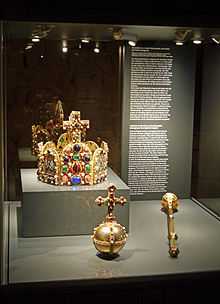
From the time of Constantine I, i.e., the fourth century A.D., the Roman emperors had, with very few exceptions, taken on a role as promoters and defenders of Christianity. The title of Emperor became defunct in Western Europe after the deposition of Romulus Augustulus in 476 AD; both the title and connection between Emperor and Church continued in the Eastern Roman Empire until 1453 A.D, when it fell to the forces of the Ottoman Empire. In the west, the title of Emperor (Latin: "Imperator") was revived in 800 A.D, which also renewed ideas of imperial–papal cooperation. As the papacy's power grew during the Middle Ages, popes and emperors came into conflict over church administration. The best-known and most bitter conflict was that known as the Investiture Controversy, fought during the 11th century between Henry IV and Pope Gregory VII.
After Charlemagne was crowned Emperor of the Romans (Latin: Imperator Romanorum) by the Pope, his successors maintained the title until the death of Berengar I of Italy in 924. No pope appointed an emperor again until the coronation of Otto the Great in 962. Under Otto and his successors, much of the former Carolingian kingdom of Eastern Francia fell within the boundaries of the Holy Roman Empire. The various German princes elected one of their peers as King of the Germans, after which he would be crowned as emperor by the Pope. After Charles V's coronation, all succeeding emperors were legally emperors-elect due to the lack of papal coronation, but for all practical purposes they were simply called emperors.
The term "sacrum" (i.e. "holy") in connection with the medieval Roman Empire was first used in 1157 under Frederick I Barbarossa.[4] Charles V was the last Holy Roman Emperor to be crowned by the Pope (1530). The final Holy Roman Emperor-elect, Francis II, abdicated in 1806 during the Napoleonic Wars that saw the Empire's final dissolution.
The standard designation of the Holy Roman Emperor was "August Emperor of the Romans" (Romanorum Imperator Augustus). When Charlemagne was crowned in 800, his was styled as "most serene Augustus, crowned by God, great and pacific emperor, governing the Roman Empire," thus constituting the elements of "Holy" and "Roman" in the imperial title. The word Holy had never been used as part of that title in official documents.[5]
The word Roman was a reflection of the translatio imperii (transfer of rule) principle that regarded the (Germanic) Holy Roman Emperors as the inheritors of the title of Emperor of the Western Roman Empire, despite the continued existence of the Eastern Roman Empire.
Succession of the Holy Roman Emperors
_family_tree_by_shakko_(DE).jpg)
Successions to the kingship were controlled by a variety of complicated factors. Elections meant the kingship of Germany was only partially hereditary, unlike the kingship of France, although sovereignty frequently remained in a dynasty until there were no more male successors. Some scholars suggest that the task of the elections was really to solve conflicts only when the dynastic rule was unclear, yet the process meant that the prime candidate had to make concessions, by which the voters were kept on side, which were known as Wahlkapitulationen (election capitulations).
The Electoral council was set at seven princes (three archbishops and four secular princes) by the Golden Bull of 1356. It remained so until 1648, when the settlement of the Thirty Years' War required the addition of a new elector to maintain the precarious balance between Protestant and Catholic factions in the Empire. Another elector was added in 1690, and the whole college was reshuffled in 1803, a mere three years before the dissolution of the Empire.
After 1438, the Kings remained in the house of Habsburg and Habsburg-Lorraine, with the brief exception of Charles VII, who was a Wittelsbach. Maximilian I (Emperor 1508–1519) and his successors no longer travelled to Rome to be crowned as Emperor by the Pope. Maximilian therefore named himself Elected Roman Emperor (Erwählter Römischer Kaiser) in 1508 with papal approval. This title was in use by all his uncrowned successors. Of his successors only Charles V, the immediate one, received a papal coronation.
List of emperors
This list includes all emperors of the Holy Roman Empire, whether or not they styled themselves Holy Roman Emperor. There are some gaps in the tally. For example, Henry the Fowler was King of Germany but not Emperor; Emperor Henry II was numbered as his successor as German King. The Guideschi follow the numeration for the Duchy of Spoleto.
Emperors before Otto the Great
Traditional historiography claimed a continuity between the Carolingian Empire and the Holy Roman Empire. This is rejected by some modern historians, who date the foundation of the Holy Roman Empire to 962. The rulers who were crowned as Emperors in the West before 962 were as follows:
Carolingian dynasty
| Image | Name | Life | Coronation | Ceased to be Emperor | Descent from Emperor | Coin |
|---|---|---|---|---|---|---|
 |
Charles I (Charlemagne) |
2 April 742 - 28 January 814 |
25 December 800 | 28 January 814 | Founder of the Holy Roman Empire | 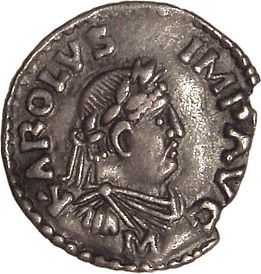 |
 |
Louis I | 778 - 20 June 840 |
1st 11 September 813 [6] 2nd 5 October 816 |
20 June 840 | son of Emperor Charles I | 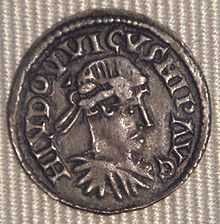 |
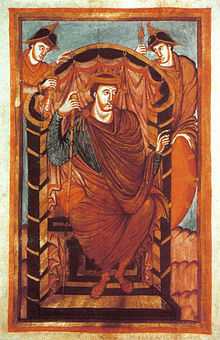 |
Lothair I | 795 - 29 September 855 |
5 April 823 | 29 September 855 | son of Emperor Louis I | 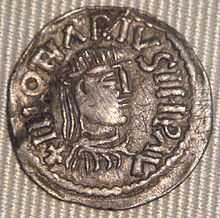 |
 |
Louis II | 825 - 12 August 875 |
1st Easter 850 2nd 18 May 872 |
12 August 875 | son of Emperor Lothair I |  |
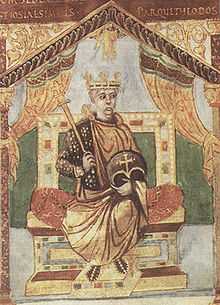 |
Charles II | 13 June 823 - 6 October 877 |
29 December 875 | 6 October 877 | son of Emperor Louis I |  |
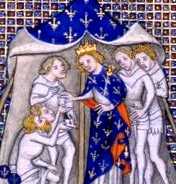 |
Charles III | 13 June 839 - 13 January 888 |
12 February 881 | 13 January 888 | grandson of Emperor Louis I | 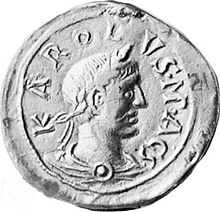 |
Guideschi dynasty
| Image | Name | Life | Coronation | Ceased to be Emperor | Descent from Emperor | Coin |
|---|---|---|---|---|---|---|
 |
Guy | 855 - 12 December 894 |
May 891 | 12 December 894 | great-great grandson of Emperor Charles I | – |
 |
Lambert | 880 - 15 October 898 |
30 April 892 | 15 October 898 | son of Emperor Guy | – |
Carolingian dynasty
| Image | Name | Life | Coronation | Ceased to be Emperor | Descent from Emperor | Coin |
|---|---|---|---|---|---|---|
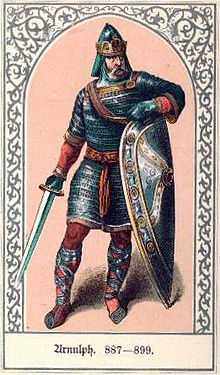 |
Arnulph | 850 - 8 December 899 |
22 February 896 | 8 December 899 | nephew of Charles III and great-grandson of Emperor Louis I |
– |
Bosonid dynasty
| Image | Name | Life | Coronation | Ceased to be Emperor | Descent from Emperor | Coin |
|---|---|---|---|---|---|---|
 |
Louis III | 880 - 28 June 928 |
22 February 901 | 21 July 905 | grandson of Emperor Louis II | – |
Unruoching dynasty
| Image | Name | Life | Coronation | Ceased to be Emperor | Descent from Emperor | Coin |
|---|---|---|---|---|---|---|
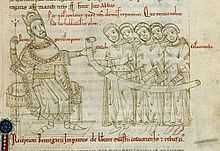 |
Berengar | 845 - 7 April 924 |
December 915 | 7 April 924 | grandson of Emperor Louis I |  |
There was no emperor in the west between 924 and 962.
Holy Roman Emperors
Ottonian (Saxon) dynasty
| # | Image | Name | Life | Election | Coronation | Ceased to be Emperor | Descent from Emperor | Seal |
|---|---|---|---|---|---|---|---|---|
| 1 |  |
Otto I | 23 November 912 - 7 May 973 |
– | 2 February 962 | 7 May 973 | great-great-great grandson of Emperor Louis I |  |
| 2 |  |
Otto II | 955 - 7 December 983 |
961 | 25 December 967 | 7 December 983 | son of Emperor Otto I | |
| 3 | 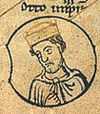 |
Otto III | 980 - 23 January 1002 |
June 983 | 21 May 996 | 23 January 1002 | son of Emperor Otto II |  |
| 4 |  |
Henry II [7] |
6 May 973 - 13 July 1024 |
7 June 1002 | 14 February 1014 | 13 July 1024 | second cousin of Emperor Otto III and great-great-great-great-great grandson of Emperor Louis I | |
Salian (Frankish) dynasty
| # | Image | Name | Life | Election | Coronation | Ceased to be Emperor | Descent from Emperor | Seal |
|---|---|---|---|---|---|---|---|---|
| 5 | 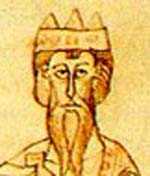 |
Conrad II [8] |
990 - 4 June 1039 |
1024 | 26 March 1027 | 4 June 1039 | great-great-grandson of Emperor Otto I | |
| 6 |  |
Henry III | 29 October 1017 - 5 October 1056 |
1028 | 25 December 1046 | 5 October 1056 | son of Emperor Conrad II | 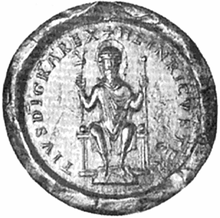 |
| 7 |  |
Henry IV | 11 November 1050 - 7 August 1106 |
1053 | 31 March 1084 | December 1105 | son of Emperor Henry III |  |
| 8 |  |
Henry V [9] |
8 November 1086 - 23 May 1125 |
6 January 1099 | 13 April 1111 | 23 May 1125 | son of Emperor Henry IV |  |
Supplinburg dynasty
| # | Image | Name | Life | Election | Coronation | Ceased to be Emperor | Descent from Emperor | Seal |
|---|---|---|---|---|---|---|---|---|
| 9 |  |
Lothair III [10] |
9 June 1075 - 4 December 1137 |
1125 | 4 June 1133 | 4 December 1137 | 9th generation descendant of Emperor Otto I and also 11th generation descendant of Emperor Charles II |
 |
Staufen (or Hohenstaufen) dynasty
| # | Image | Name | Life | Election | Coronation | Ceased to be Emperor | Descent from Emperor | Arms |
|---|---|---|---|---|---|---|---|---|
| 10 | 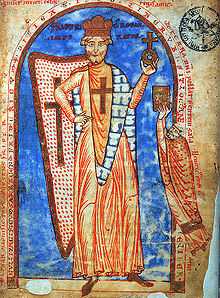 |
Frederick I | 1122 - 10 June 1190 |
4 March 1152 | 18 June 1155 | 10 June 1190 | great-grandson of Emperor Henry IV |  |
| 11 | 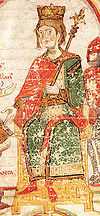 |
Henry VI | November 1165 - 28 September 1197 |
? April 1169 | 14 April 1191 | 28 September 1197 | son of Emperor Frederick I |  |
Welf dynasty
| # | Image | Name | Life | Election | Coronation | Ceased to be Emperor | Descent from Emperor | Arms |
|---|---|---|---|---|---|---|---|---|
| 12 |  |
Otto IV | 1175 or 1176 - 19 May 1218 |
9 June 1198 | 4 October 1209 | 1215 | great-grandson of Emperor Lothair III | 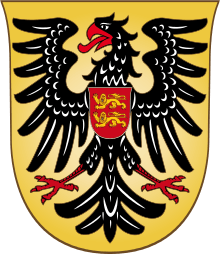 |
Staufen (or Hohenstaufen) dynasty
| # | Image | Name | Life | Election | Coronation | Ceased to be Emperor | Descent from Emperor | Arms |
|---|---|---|---|---|---|---|---|---|
| 13 | 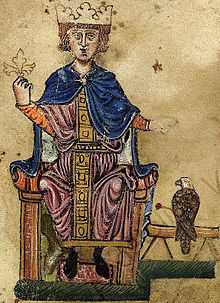 |
Frederick II | 26 December 1194 - 13 December 1250 |
1196 1215 re-election |
22 November 1220 | 13 December 1250 | son of Emperor Henry VI |  |
House of Luxembourg
| # | Image | Name | Life | Election | Coronation | Ceased to be emperor | Descent from emperor | Arms |
|---|---|---|---|---|---|---|---|---|
| 14 |  |
Henry VII | 1275/1279 - 24 August 1313 |
1308 | 29 June 1312 | 24 August 1313 | 13th generation descendant of Emperor Louis III |  |
House of Wittelsbach
| # | Image | Name | Life | Election | Coronation | Ceased to be emperor | Descent from emperor | Arms |
|---|---|---|---|---|---|---|---|---|
| 15 | 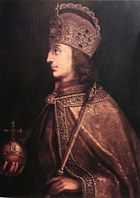 |
Louis IV | 1 April 1282 - 11 October 1347 |
October 1314 | 17 January 1328 | 11 October 1347 | 6th generation descendant of Emperor Lothair III and 7th generation descendant of Henry IV, Holy Roman Emperor | 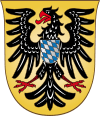 |
House of Luxembourg
| # | Image | Name | Life | Election | Coronation | Ceased to be emperor | Descent from emperor | Arms |
|---|---|---|---|---|---|---|---|---|
| 16 | 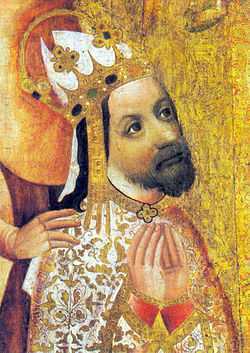 |
Charles IV | 14 May 1316 - 29 November 1378 |
11 July 1346/ 17 June 1349 re-election |
5 April 1355 | 29 November 1378 | grandson of Emperor Henry VII |  |
| 17 | 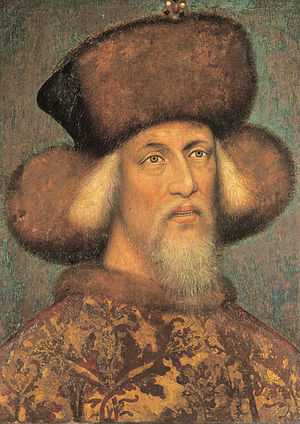 |
Sigismund | 14 February 1368 - 9 December 1437 |
10 September 1410/ 21 July 1411 re-election |
31 May 1433 | 9 December 1437 | son of Emperor Charles IV |  |
House of Habsburg
| # | Image | Name | Life | Election | Coronation | Ceased to be emperor | Descent from emperor | Arms |
|---|---|---|---|---|---|---|---|---|
| 18 | 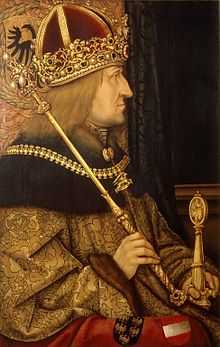 |
Frederick III | 21 September 1415 - 19 August 1493 |
1440 | 19 March 1452 | 19 August 1493 | 10th generation descendant of Emperor Lothair III |  |
| 19 | 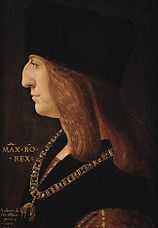 |
Maximilian I | 22 March 1459 - 12 January 1519 |
16 February 1486 | - [11] |
12 January 1519 | son of Emperor Frederick III |  |
| 20 | 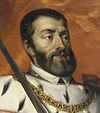 |
Charles V | 24 February 1500 - 21 September 1558 |
28 June 1519 | February 1530 | 16 January 1556 | grandson of Emperor Maximilian I |  |
| 21 | _-_Emperor_Ferdinand_I_-_WGA02326.jpg) |
Ferdinand I | 10 March 1503 - 25 July 1564 |
1531 | - [11] |
25 July 1564 | grandson of Emperor Maximilian I |  |
| 22 |  |
Maximilian II | 31 July 1527 - 12 October 1576 |
November 1562 | - [11] |
12 October 1576 | son of Emperor Ferdinand I |  |
| 23 | 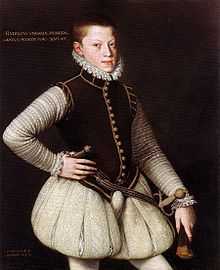 |
Rudolph II [12] |
18 July 1552 - 20 January 1612 |
1575 | 30 June 1575 | 20 January 1612 | son of Emperor Maximilian II |  |
| 24 | 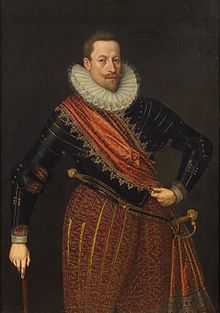 |
Matthias | 24 February 1557 - 20 March 1619 |
1612 | 23 January 1612 | 20 March 1619 | son of Emperor Maximilian II |  |
| 25 |  |
Ferdinand II | 9 July 1578 - 15 February 1637 |
1618 | 10 March 1619 | 15 February 1637 | grandson of Emperor Ferdinand I |  |
| 26 | 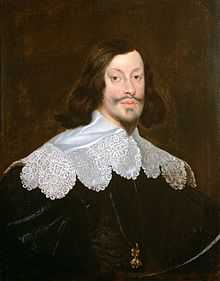 |
Ferdinand III | 13 July 1608 - 2 April 1657 |
1636 | 18 November 1637 | 2 April 1657 | son of Emperor Ferdinand II |  |
| 27 | 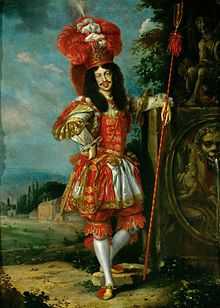 |
Leopold I | 9 June 1640 - 5 May 1705 |
18 July 1658 | 6 March 1657 | 5 May 1705 | son of Emperor Ferdinand III |  |
| 28 |  |
Joseph I | 26 July 1678 - 17 April 1711 |
6 January 1690 | 1 May 1705 | 17 April 1711 | son of Emperor Leopold I |  |
| 29 | 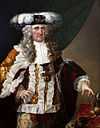 |
Charles VI | 1 October 1685 - 20 October 1740 |
12 October 1711 | 22 December 1711 | 20 October 1740 | son of Emperor Leopold I |  |
House of Wittelsbach
| # | Image | Name | Life | Election | Coronation | Ceased to be emperor | Descent from emperor | Arms |
|---|---|---|---|---|---|---|---|---|
| 30 | 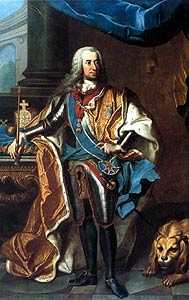 |
Charles VII [11] |
6 August 1697 - 20 January 1745 |
24 January 1742 | 12 February 1742 | 20 January 1745 | great-great grandson of Emperor Ferdinand II and 12th generation descendant of Louis IV, Holy Roman Emperor |  |
House of Habsburg-Lorraine
| # | Image | Name | Life | Election | Coronation | Ceased to be emperor | Descent from emperor | Arms |
|---|---|---|---|---|---|---|---|---|
| 31 | 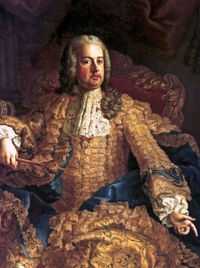 |
Francis I | 8 December 1708 - 18 August 1765 |
13 September 1745 | - [11] |
18 August 1765 | great-grandson of Emperor Ferdinand III |  |
| 32 |  |
Joseph II | 13 March 1741 - 20 February 1790 |
after 18 August 1765 | 19 August 1765 | 20 February 1790 | son of Emperor Francis I and maternal grandson of Emperor Charles VI |  |
| 33 | 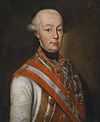 |
Leopold II | 5 May 1747 - 1 March 1792 |
after 20 February 1790 | - [11] |
1 March 1792 | son of Emperor Francis I and maternal grandson of Emperor Charles VI |  |
| 34 | 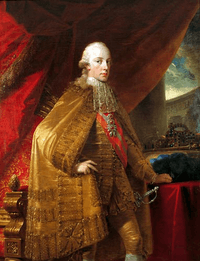 |
Francis II | 12 February 1768 - 2 March 1835 |
after 1 March 1792 | 4 March 1792 | 6 August 1806 | son of Emperor Leopold II |  |
Coronation
The Emperor was crowned in a special ceremony, traditionally performed by the Pope in Rome, using the Imperial Regalia. Without that coronation, no king, despite exercising all powers, could call himself Emperor. In 1508, Pope Julius II allowed Maximilian I to use the title of Emperor without coronation in Rome, though the title was qualified as Electus Romanorum Imperator ("elected Emperor of the Romans"). Maximilian's successors adopted the same titulature, usually when they became the sole ruler of the Holy Roman Empire. Maximilian's first successor Charles V was the last to be crowned Emperor.
| Emperor | Coronation date | Officiant | Location |
|---|---|---|---|
| Charles I | 25 December 800 | Pope Leo III | Rome, Italy |
| Louis I | 5 October 816 | Pope Stephen IV | Reims, France |
| Lothair I | 5 April 823 | Pope Paschal I | Rome, Italy |
| Louis II | 15 June 844 | Pope Leo IV | Rome, Italy |
| Charles II | 29 December 875 | Pope John VIII | Rome, Italy |
| Charles III | 12 February 881 | Rome, Italy | |
| Guy III of Spoleto | 21 February 891 | Pope Stephen V | Rome, Italy |
| Lambert II of Spoleto | 30 April 892 | Pope Formosus | Ravenna, Italy |
| Arnulf of Carinthia | 22 February 896 | Rome, Italy | |
| Louis III | 15 or 22 February 901 | Pope Benedict IV | Rome, Italy |
| Berengar | December 915 | Pope John X | Rome, Italy |
| Otto I | 2 February, 962 | Pope John XII | Rome, Italy |
| Otto II | 25 December, 967 | Pope John XIII | Rome, Italy |
| Otto III | 21 May, 996 | Pope Gregory V | Monza, Italy |
| Henry II | 14 February 1014 | Pope Benedict VIII | Rome, Italy |
| Conrad II | 26 March 1027 | Pope John XIX | Rome, Italy |
| Henry III | 25 December 1046 | Pope Clement II | Rome, Italy |
| Henry IV | 31 March 1084 | Antipope Clement III | Rome, Italy |
| Henry V | 13 April 1111 | Pope Paschal II | Rome, Italy |
| Lothair III | 4 June 1133 | Pope Innocent II | Rome, Italy |
| Frederick I | 18 June 1155 | Pope Adrian IV | Rome, Italy |
| Henry VI | 14 April 1191 | Pope Celestine III | Rome, Italy |
| Otto IV | 4 October 1209 | Pope Innocent III | Rome, Italy |
| Frederick II | 22 November 1220 | Pope Honorius III | Rome, Italy |
| Henry VII | 29 June 1312 | Ghibellines cardinals | Rome, Italy |
| Louis IV | 17 January 1328 | Senator Sciarra Colonna | Rome, Italy |
| Charles IV | 5 April 1355 | Pope Innocent VI's cardinal | Rome, Italy |
| Sigismund | 31 May 1433 | Pope Eugenius IV | Rome, Italy |
| Frederick III | 19 March 1452 | Pope Nicholas V | Rome, Italy |
| Charles V | 24 February 1530 | Pope Clement VII | Bologna, Italy |
See also
| Wikimedia Commons has media related to Holy Roman Emperors. |
- Concordat of Worms
- Emperor for other uses of the title "Emperor" in western Europe.
- First Council of the Lateran
- Holy Roman Emperors family tree
- Holy Roman Empress
- King of the Romans
- List of German monarchs
- Holy Roman Empire
References
- ↑ Peter Hamish Wilson, The Holy Roman Empire, 1495–1806, MacMillan Press 1999, London, page 2
- ↑ Erik von Kuehnelt-Leddihn: The Menace of the Herd or Procrustes at Large – Page: 164
- ↑ Robert Edwin Herzstein, Robert Edwin Herzstein: The Holy Roman Empire in the Middle Ages: universal state or German catastrophe?
- ↑ Peter Moraw, Heiliges Reich, in: Lexikon des Mittelalters, Munich & Zurich: Artemis 1977–1999, vol. 4, columns 2025–2028.
- ↑ Bryce, James (1968). The Holy Roman Empire. Macmillan. p. 530.
- ↑ Egon Boshof: Ludwig der Fromme. Darmstadt 1996, p. 89
- ↑ enumerated as successor of Henry I who was German King 919–936 but not Emperor.
- ↑ enumerated as successor of Conrad I who was German King 911–918 but not Emperor
- ↑ Barraclough, Geoffrey (1984). The Origins of Modern Germany. W. W. Norton & Company. ISBN 0-393-30153-2.
- ↑ enumerated as successor of Lothair II, who was King of Lotharingia 855–869 but not Emperor
- ↑ 11.0 11.1 11.2 11.3 11.4 11.5 Emperor-Elect.
- ↑ enumerated as successor of Rudolph I who was German King 1273–1291.
| |||||||||||||||||||||

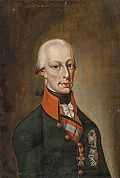
.svg.png)